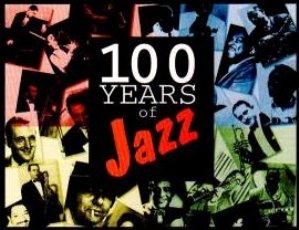100 Years of Jazz - Disc 04: Swing - Kansas City (1999)
100 Years of Jazz - Disc 04: Swing - Kansas City (1999)

1. Chick Webb and His Orchestra – Liza (All Clouds Roll Away) (02:50) 2. Ella Fitzgerald & Chick Webb – A-Tisket A-Tasket (02:37) 3. Bennie Moten and His Orchestra – Rhumba Negro (Spanish Stomp) (02:50) 4. Jimmie Lunceford and His Orchestra – Rhythm Is Our Business (03:17) 5. Jean Goldkette and His Orchestra – Birmingham Bertha (02:56) 6. McKinney’s Cotton Pickers – I'd Love It (03:06) 7. Fats Waller and His Rhythm – A Good Man Is Hard to Find (02:58) 8. Fats Waller, His Rhythm & His Orchestra – Jitterburg Waltz (03:21) 9. Benny Goodman and His Orchestra – All the Cats Join In (03:12) 10. Gene Krupa and His Orchestra – Let Me Off Uptown (03:04) 11. Luis Russell and His Burning Eight – Savoy Shout (03:00) 12. Count Basie & His Orchestra – Rock-a-Bye Basie (03:04) 13. Count Basie & His Orchestra – Harvard Blues (03:22) 14. Duke Ellington & His Orchestra – Mood Indigo (02:42) 15. Stuff Smith and His Onyx Club Boys – Twilight in Turkey (02:26) 16. Zutty Singleton & his Orchestra – King Porter Stomp (02:36) 17. Eddie Durham and His Band – Moten Swing (02:40) 18. Quintette du Hot Club de France – Minor Swing (03:15) 19. Billie Holiday & Frankie Newton and His Orchestra – Fine and Mellow (03:17) 20. Woody Herman & His Orchestra – Woodshopper's Ball (03:11) 21. Mary Lou Williams and Her Kansas City Seven – Harmony Blues (02:52)
Kansas City is world renowned for its rich jazz and blues legacy. Jazz in Kansas City was born in the 1920s and continues today in clubs and events held throughout the city. More than 40 area nightclubs feature jazz on a regular basis.
The roots of Kansas City jazz are quite varied. Blues singers of the 1920s and ragtime music greatly influenced the music scene. Settings such as dance halls, cabarets and speakeasies fostered the development of this new musical style. In the early days, many jazz groups were smaller dance bands with three to six pieces. By the mid-1920s, the big band became the most common. Territory bands also had an influential development on jazz. Many great musicians got their start in these bands, traveling up to 1,000 miles between jobs.
While jazz began in the 1920s with a bang, it flourished in the 1930s, mainly as a result of political boss Tom Pendergast. During prohibition, he allowed alcohol to flow in Kansas City. As an entertainment center, Kansas City had no equal during these dry times.
This "wide-open" town image attracted displaced musicians from everywhere in mid-America. Throughout the Depression, Kansas City bands continued to play while other bands across the nation folded. The city was shielded from the worst of the Depression due to an early form of New Deal-style public works projects that provided jobs, and affluence, that kept the dance-oriented nightlife in town swinging. Only in Kansas City did jazz continue to flourish. At one time, there were more than 100 night clubs, dance halls and vaudeville houses in Kansas City regularly featuring jazz music. Legends like Count Basie, Andy Kirk, Joe Turner, Hot Lips Page and Jay McShann all played in Kansas City. A saxophone player named Charlie Parker began his ascent to fame here in his hometown in the 1930s.
Kansas City’s 12th Street became nationally known for its jazz clubs, gambling parlors and brothels, earning the city the moniker, “The Paris of the Plains.” At its height, 12th Street was home to more than 50 jazz clubs. Just six blocks to the south, jazz also flourished at 18th & Vine, which became nationally respected as the epicenter of the city’s African-American community.
Another great outcome of Kansas City jazz was the jam session. After performances, musicians would get together to exchange ideas and experiment with new methods of playing. The best local and out of town musicians would take part in these jam sessions that lasted all night and well into the next day. ---visitkc.com
The Swing genre represents a golden age for jazz that showed its first signs in the mid-20s, but really peaked from the mid-30s to the mid-40s. Going well into the 20s, most jazz bands still played in New Orleans or Dixieland styles in which the musicians all improvised simultaneously while staying within the boundaries of the original tune's melody and harmony.
When cornetist Louis Armstrong joined Fletcher Henderson's Orchestra in 1924, the band's arranger, Don Redman, knew he had a rare talent on his hands and began to spotlight Armstrong's melodic skills. No longer would the entire band improvise, instead Armstrong would be given the freedom to take solos to new heights while the rest of the band supplied supporting riffs. This new approach to band arranging spread and reached the public at a time when people were looking for large orchestral bands that could provide an evening's worth of dance music. Thus the golden age for big band jazz was born.
From 1935 to about 1946 jazz dance bands led by the likes of Benny Goodman and Duke Ellington were the number one form of entertainment in the US. The swing era finally came to an end when new taxation laws on nightclubs made dance floors unprofitable and jazz became an entertainment for listening, not dancing. ---jazzmusicarchives.com
download (mp3 @320 kbs):








